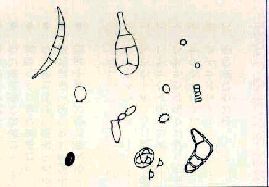Tokyo Food Safety Information Center » Good things to know » Molds and mycotoxins » Mold Q&A
Mold Q&A
What is mold?
Types of fungi
| Fungi | Mastigomycota | Saprolegnia |
|---|---|---|
| Zygomycota | Mucor, Rhizopus | |
| Ascomycota | Eurotiomycetes, Pichia | |
| Basidiomycota | Mushrooms like shiitake | |
| Fungi imperfecti | Includes most of the molds which contaminate food |
What shape do molds take?
Molds are comprised of string-like “hypha” and their spores. Molds grow by dividing and extending abundant branches of hyphae. The collection of these hyphae are called the “mycelium.” |
 |
How do molds multiply?
Under good growth conditions, mold spores can grow to sizes (colonies) visible to the naked eye in two to three days. Within a week, the colony will produce large numbers of spores and release them into the surrounding environment. These spores are transported by wind, water, and even people to new locations where they germinate and grow again. Through repetitions of this cycle, molds spread.
Molds particularly like foods which contain starches and sugars such as mochi rice cakes, bread, and snacks. However, molds are not limited to food and can use human grime, the components of paints, and even plastic as a source of nutrients to grow and create visible colonies on.
When the humidity is 70% or higher, molds can also grow in environments with less water than that required by bacteria, which is why molds grow even on dry foods. However, molds cannot grow without oxygen and almost all molds require temperatures between 10 and 30° C.
Accordingly, mold growth is affected by four factors: Nutrient source, water content, temperature, and oxygen.
What harm do molds cause?
Molds are useful to humans – they are used to produce food and medical products. Not only this, molds also, together with other microorganisms, break up the bodies of dead animals, keeping the environment clean.
Conversely, molds are a source of illness and allergies. They can grow on food, produce toxins, and cause food poisoning and cancer.
The greatest harm they cause in the end, however, is their destruction of human food, clothing, and shelter through their growth on these items.
Incidentally, molds account for approximately 3% of problems concerning food handled by the Tokyo Metropolitan Government. The reports which reach Public Health Centers, however, are only a fraction of all incidents, and it is believed that between food production and consumption, mold growth causes a massive quantity of food to become spoiled.